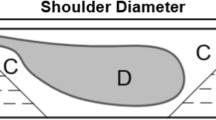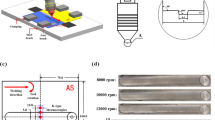Abstract
In practical engineering, finite element(FE) modeling for weld seam is commonly simplified by neglecting its inhomogeneous mechanical properties. This will cause a significant loss in accuracy of FE forming analysis, in particular, for friction stir welded(FSW) blanks due to the large width and good formability of its weld seam. The inhomogeneous mechanical properties across weld seam need to be well characterized for an accurate FE analysis. Based on a similar AA5182 FSW blank, the metallographic observation and micro-Vickers hardness analysis upon the weld cross-section are performed to identify the interfaces of different sub-zones, i.e., heat affected zone(HAZ), thermal-mechanically affected zone(TMAZ) and weld nugget(WN). Based on the rule of mixture and hardness distribution, a constitutive model is established for each sub-zone to characterize the inhomogeneous mechanical properties across the weld seam. Uniaxial tensile tests of the AA5182 FSW blank are performed with the aid of digital image correlation(DIC) techniques. Experimental local stress-strain curves are obtained for different weld sub-zones. The experimental results show good agreement with those derived from the constitutive models, which demonstrates the feasibility and accuracy of these models. The proposed research gives an accurate characterization of inhomogeneous mechanical properties across the weld seam produced by FSW, which provides solutions for improving the FE simulation accuracy of FSW sheet forming.
Similar content being viewed by others
References
THOMAS W M. Friction stir butt welding[P]. International Patent Application No. PCT/GB92/0220, 1991.
LI Y, MURR L E, MCCLURE J C. Solid-state flow visualization in the friction-stir welding of 2024 Al to 6061 Al[J]. Scripta Materialia, 1999, 40(9): 1041–1046.
SARSILMAZ F, ÇAYDAŞ U, HASÇALIK A, et al. The joint properties of dissimilar aluminum plates joined by friction stir welding[J]. International Journal of Materials Research, 2010, 101(5): 692–699.
LEE W B, YEON Y M, JUNG S B. The improvement of mechanical properties of friction-stir-welded A356 Al alloy[J]. Materials Science and Engineering: A, 2003, 355(1): 154–159.
SPRINGER H, KOSTKA A, DOS SANTOS J F, et al. Influence of intermetallic phases and Kirkendall-porosity on the mechanical properties of joints between steel and aluminium alloys[J]. Materials Science and Engineering: A, 2011, 528(13): 4630–4642.
WATANABE T, TAKAYAMA H, YANAGISAWA A. Joining of aluminum alloy to steel by friction stir welding[J]. Journal of Materials Processing Technology, 2006, 178(1): 342–349.
KOSTKA A, COELHO R S, DOS SANTOS J F, et al. Microstructure of friction stir welding of aluminium alloy to magnesium alloy[J]. Scripta Materialia, 2009, 60(11): 953–956.
VENKATESWARAN P, XU Z H, LI X, et al. Determination of mechanical properties of Al-Mg alloys dissimilar friction stir welded interface by indentation methods[J]. Journal of Materials Science, 2009, 44(15): 4140–4147.
KUSUDA Y. Honda develops robotized FSW technology to weld steel and aluminum and applied it to a mass-production vehicle[J]. Industrial Robot: An International Journal, 2013, 40(3): 208–212.
ECHEVERRIA A. Aluminium-steel dissimilar joints for automotive applications produced by FSW and FSSW[C]//9th International Conference on Trends in Welding Research, Chicago, IL, USA, June 4–8, 2012.
LI S, LIN Z, NI J, et al. Current development and trends of the tailored blank application in auto-body stamping[J]. Chinese Journal of Mechanical Engineering, 2002, 38(2): 1–7.
MA X, GUAN Y, YANG L. Determination of elastoplastic mechanical properties of the weld and heat affected zone metals in tailor-welded blanks by nanoindentation test[J]. Chinese Journal of Mechanical Engineering, 2015: 1–8.
RAYMOND S D, WILD P M, BAYLEY C J. On modeling of the weld line in finite element analyses of tailor-welded blank forming operations[J]. Journal of Materials Processing Technology, 2004, 147(1): 28–37.
SONG Y, HUA L, CHU D, et al. Characterization of the inhomogeneous constitutive properties of laser welding beams by the micro-Vickers hardness test and the rule of mixture[J]. Materials & Design, 2012, 37: 19–27.
AMANCIO-FILHO S T, SHEIKHI S, DOS SANTOS J F, et al. Preliminary study on the microstructure and mechanical properties of dissimilar friction stir welds in aircraft aluminium alloys 2024-T351 and 6056-T4[J]. Journal of Materials Processing Technology, 2008, 206(1): 132–142.
NIELSEN K L, PARDOEN T, TVERGAARD V, et al. Modelling of plastic flow localisation and damage development in friction stir welded 6005A aluminium alloy using physics based strain hardening law[J]. International Journal of Solids and Structures, 2010, 47(18): 2359–2370.
MILIAN J L, ADONYI Y. Formability of tailored blanks for automotive applications[C]//34th Mechanical Working and Steel Processing Conference Proceedings, Montreal, Quebec, Canada, October 25–28, 1992: 83–91.
ZHAN M, DU H, LIU J, et al. A method for establishing the plastic constitutive relationship of the weld bead and heat-affected zone of welded tubes based on the rule of mixtures and a microhardness test[J]. Materials Science and Engineering: A, 2010, 527(12): 2864–2874.
ZADPOOR A A, SINKE J, BENEDICTUS R, et al. Mechanical properties and microstructure of friction stir welded tailor-made blanks[J]. Materials Science and Engineering: A, 2008, 494(1): 281–290.
ASTM International. Standard E8/E8M––2009 Standard test methods for tension testing of metallic materials[S]. West Conshohocken, PA, USA: American Society for Testing and Materials, 2009.
KIM D, LEE W, KIM J, et al. Macro-performance evaluation of friction stir welded automotive tailor-welded blank sheets: Part II––Formability[J]. International Journal of Solids and Structures, 2010, 47(7): 1063–1081.
TEKKAYA A E, LANGE K. An improved relationship between Vickers hardness and yield stress for cold formed materials and its experimental verification[J]. CIRP Annals-Manufacturing Technology, 2000, 49(1): 205–208.
GIANNAKOPOULOS A E, SURESH S. Determination of elastoplastic properties by instrumented sharp indentation[J]. Scripta Materialia, 1999, 40(10): 1191–1198.
CHAUDHRI M M. Subsurface strain distribution around Vickers hardness indentations in annealed polycrystalline copper[J]. Acta Materialia, 1998, 46(9): 3047–3056.
TABOR D. A simple theory of static and dynamic hardness[J]. Proceedings of the Royal Society of London A: Mathematical, Physical and Engineering Sciences, 1948, 192(1029): 247–274.
BALAN T, CAZACU O. Elastic-plastic ductile damage model based on strain-rate plastic potential[J]. Mechanics Research Communications, 2013, 54: 21–26.
ROQUE A P, JORGE R M N, PARENTE M P L, et al. Influence of the heat affected zone on hydroforming with tailor-welded tubular blanks[C]//VIII International Conference on Computational Plasticity, Barcelona, Spain, September 5–8, 2005: 1–4.
LEITÃO C, GALVÃO I, LEAL R M, et al. Determination of local constitutive properties of aluminium friction stir welds using digital image correlation[J]. Materials & Design, 2012, 33: 69–74.
Author information
Authors and Affiliations
Corresponding author
Additional information
Supported by National Natural Science Foundation of China(Grant No. 51375346), and Doctoral Fund of Ministry of Education of China(Grant No. 20110072110056)
Biographical notes
ZHANG Ling, born in 1987, is currently a PhD candidate at School of Mechanical Engineering, Tongji University, China. His research interests include advanced forming technologies and autobody light-weighting.
MIN Junying, born in 1986, is currently a postdoc(Humboldt Research Fellowship) at Ruhr-University Bochum, Germany. His research interests include advanced material models, advanced experimental methods with digital image correlation techniques and advanced forming and joining technologies.
WANG Bin, born in 1989, received his master degree from School of Mechanical Engineering, Tongji University, China, in 2015. His research interests include sheet metal forming and tailor welded blanks technology.
LIN Jianping, born in 1958, is currently a professor and a PhD supervisor at School of Mechanical Engineering, Tongji University, China. His research interests include advanced forming technologies and automotive light-weighting.
LI Fangfang, born in 1987, is currently a PhD candidate at School of Mechanical Engineering, Tongji University, China. Her research interest includes advanced forming technologies.
LIU Jing, born in 1987, received his master degree from School of Mechanical Engineering, Tongji University, China, in 2013.
Rights and permissions
About this article
Cite this article
Zhang, L., Min, J., Wang, B. et al. Constitutive model of friction stir weld with consideration of its inhomogeneous mechanical properties. Chin. J. Mech. Eng. 29, 357–364 (2016). https://doi.org/10.3901/CJME.2016.0105.002
Received:
Revised:
Accepted:
Published:
Issue Date:
DOI: https://doi.org/10.3901/CJME.2016.0105.002




